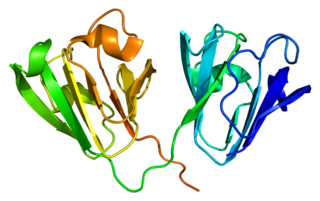In anatomy, a crystallin is a water-soluble structural protein found in the lens and the cornea of the eye accounting for the transparency of the structure. It has also been identified in other places such as the heart, and in aggressive breast cancer tumors. Since it has been shown that lens injury may promote nerve regeneration, crystallin has been an area of neural research. So far, it has been demonstrated that crystallin β b2 (crybb2) may be a neurite-promoting factor.

Phosphatidylinositol 3-kinase regulatory subunit beta is an enzyme that in humans is encoded by the PIK3R2 gene.

Alpha-crystallin B chain is a protein that in humans is encoded by the CRYAB gene. It is part of the small heat shock protein family and functions as molecular chaperone that primarily binds misfolded proteins to prevent protein aggregation, as well as inhibit apoptosis and contribute to intracellular architecture. Post-translational modifications decrease the ability to chaperone. Mutations in CRYAB cause different cardiomyopathies, skeletal myopathies mainly myofibrillar myopathy, and also cataracts. In addition, defects in this gene/protein have been associated with cancer and neurodegenerative diseases such as Alzheimer's disease and Parkinson's disease.

CCAAT/enhancer-binding protein delta is a protein that in humans is encoded by the CEBPD gene.

The alpha-2A adrenergic receptor, also known as ADRA2A, is an α2 adrenergic receptor, and also denotes the human gene encoding it.

Gamma-crystallin D is a protein that in humans is encoded by the CRYGD gene.

Guanine nucleotide-binding protein G(I)/G(S)/G(T) subunit beta-2 is a protein that in humans is encoded by the GNB2 gene.

Lens fiber major intrinsic protein also known as aquaporin-0 is a protein that in humans is encoded by the MIP gene.

Beta-crystallin B2 is a protein that in humans is encoded by the CRYBB2 gene.

Heat shock protein beta-2 is a protein that in humans is encoded by the HSPB2 gene.

Transcription factor Maf also known as proto-oncogene c-Maf or V-maf musculoaponeurotic fibrosarcoma oncogene homolog is a transcription factor that in humans is encoded by the MAF gene.

Beta-crystallin B1 is a protein that in humans is encoded by the CRYBB1 gene. Variants in CRYBB1 are associated with autosomal dominant congenital cataract.

Gamma-crystallin B is a protein that in humans is encoded by the CRYGB gene.

Beta-crystallin A3 is a protein that in humans is encoded by the CRYBA1 gene.

Gamma-crystallin S is a protein that in humans is encoded by the CRYGS gene.

Guanine nucleotide-binding protein G(T) subunit gamma-T1 is a protein that in humans is encoded by the GNGT1 gene. Either GNGT1 or GNGT2 is the gamma subunit (Gγ) of the Gβγ part of transducin, a heterotrimeric G-protein naturally expressed in vertebrate retina rod and cone cells. GNGT1 only occurs in rod cells, and GNGT2 only occurs in cone cells, with a different alpha (Gα) subunit.

Beta-crystallin A4 is a protein that in humans is encoded by the CRYBA4 gene.

Beta-crystallin B3 is a protein that in humans is encoded by the CRYBB3 gene.

Gamma-crystallin A is a protein that in humans is encoded by the CRYGA gene.

Alpha-crystallin A chain is a protein that in humans is encoded by the CRYAA gene.






















